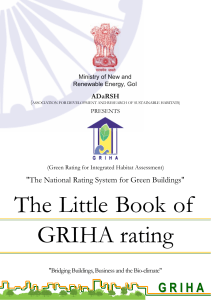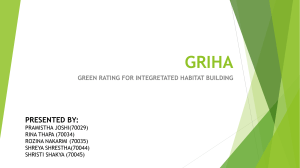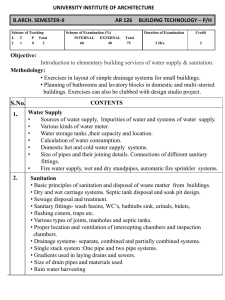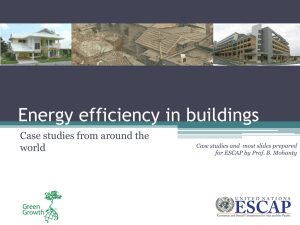Griha - Solar Passiv.. - Maharashtra Energy Development Agency
advertisement
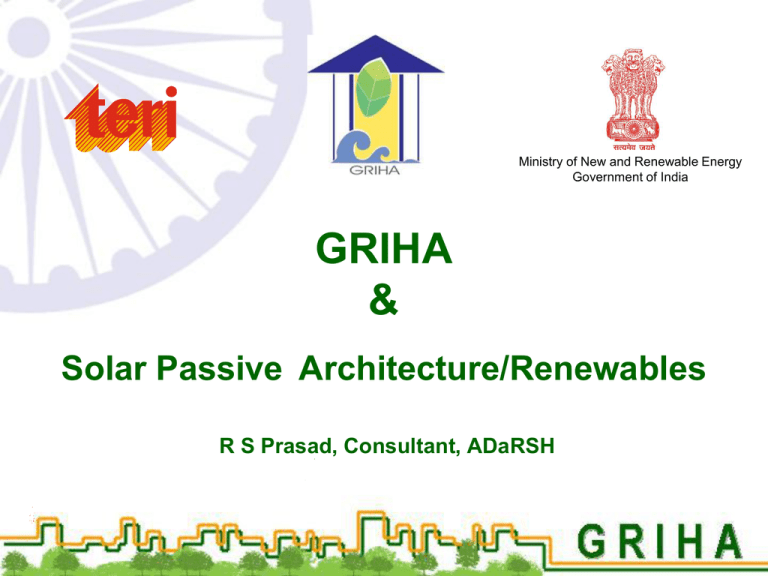
Ministry of New and Renewable Energy Government of India GRIHA & Solar Passive Architecture/Renewables R S Prasad, Consultant, ADaRSH What is a Green Building? A green building is a building which provide comfortable living and working conditions to its occupants while minimizing its detrimental impact on the environment. Difference between Energy Efficient and Green An Energy Efficient building will only conserve energy as compared to other buildings A Green Building will conserve energy; conserve water; conserve the landscape; reduce waste generation; adopt recycling and reuse of materials; and use low-energy materials Green building design calls for: integrated and coordinated design approach ….in planning, design, construction and management What is GRIHA? Green Rating for Integrated Habitat Assessment Tool to facilitate design, construction, operation of a green building ,and in turn ….measure “greenness” of a building in India What gets measured gets managed Highlights Set of 34 criteria 100 (+4 innovation points) point system with differential weightage on various criteria 51 - 60 61 - 70 71 - 80 81- 90 91- 100 Weightage based on our National Priorities GRIHA innovation points over and above 100 points Key highlights of GRIHA Sets out guidelines for design, construction and operation Combination of qualitative and quantitative criteria Sets performances benchmarks for key resources like, energy and water Facilitates integration of traditional knowledge on architecture with present day technology Integrates all relevant Indian codes and standards(e.g National building code 2005, Energy Conservation Building Code 2007, IS codes) Is in complete alignment with government policies and programs (e.g Environmental clearance by the MoEF) Key highlights of GRIHA Building types Commercial Residential Institutional 5 climatic zones Hot – Dry Warm – Humid Composite Temperate Cold Salient features 30-40% reduction in operation cost with negligible impact on project cost. A simple inclusive single window process from Design to Rating Inclusive process with high degree of hand holding from ADaRSH Only rating system that exclusively covers ventilated, air conditioned and non-air conditioned buildings/campuses 140 projects with about 7 million square metres registered with GRIHA GRIHA Compliant Building: Beyond ECBC ECBC Compliance: 37% •Insulation •High Performance glass •Controls •Efficient electrical , mechanical and lighting systems Incremental cost: 15% Payback period < 5 years 45% GRIHA Compliance: kWhr/yr •ECBC + •Passive principles (shading, orientation, controlled glass area) •Higher indoor design conditions (higher by 1 deg C) •Optimized lighting design No further incremental cost Payback period: < 4 years Designing a green building! By adopting the integrated design approach such that the client, architect, engineers, and consultants design the building in a coordinated manner with a common goal – sustainability. By optimizing site conditions (trees, water bodies, windflow, orientation, etc.) and retain them to cater to the local thermal / visual comfort requirements of the building By adopting sound architectural practices and taking examples from India’s traditional architecture By following India’s national codes and standards By designing precisely-sized energy systems and not basing them on broad thumb-rules Designing a green building! (Continued…) By following regional development plans (such as the UDPFI guidelines, master plans) and local building by-laws By adopting locally available construction materials and giving impetus to local arts, crafts, architecture and artisans By reducing the resource consumption of the building and its inhabitants so that the waste generating there-from is reduced By adopting energy efficient technologies (EETs) and equipment By adopting renewable energy technology (RETs) applications to reduce the demand on conventional energy GRIHA-Green Rating for Integrated Habitat Assessment GRIHA attempts to minimize a building’s resource consumption, waste generation, and overall ecological/ environmental impact by consistent with nationally acceptable limits / benchmarks. It does so using the five ‘R’ philosophy of sustainable development, namely – to blindly adopt international trends, materials, technologies, products, etc. Specially in areas where local substitutes/equivalents are available Reduce – the dependence on high energy products, systems, processes, etc. Reuse – materials, products, traditional technologies, so as to reduce the costs incurred in designing buildings as well as in operating them Recycle – all possible wastes generated from the building site, during construction, operation and demolition Reinvent – engineering systems, designs, and practices such that India creates global examples that the world can follow rather than us following international examples Refuse Why should you get your building rates? Some of the benefits of a green design to a building owner, user, and the society as a whole are as follows: Reduced energy consumption without sacrificing the comfort levels (lower operational costs) Reduced water consumption Reduced system sizes (HVAC, transformers, cabling, etc.) for optimal performance at local conditions. Reduced investment (Lifecycle costs) Reduced destruction of natural areas, habitats, and biodiversity, and reduced soil loss from erosion etc. Reduced air and water pollution (with direct health benefits) Limited waste generation due to recycling and reuse Reduced pollution loads Increased user productivity Enhanced image and marketability Passive Solar Architecture Is the design of buildings whose orientation, forms, shading, materials, fenestration(window/door openings) and site planning enable the structure to naturally store thermal energy from the sun and/or cool the structure by shielding it from the sun rays and causing on unassisted air flow. Mankind has been using passive solar majors since time immemorial. The traditional buildings in India bear testimony to it. Passive solar techniques are as varied as architecture itself and depend upon the climatic regions. Can buildings adopt traditional design principles and yet appear contemporary? IRRAD complex Source: Ashok Lall Architects Pearl Fashion Academy Architects: Morphogenesis http://img248.imageshack.us/i/pearlacademyfashion1mp0.jpg/ http://img248.imageshack.us/i/pearlacademyfashion1mp0.jpg/ http://static.dezeen.com/uploads/2009/09/pearl-academy-by-morphogenesis-17.jpg Design to reduce conventional energy demand (Based on principles of solar passive design) Conventional ‘adopt international design’ Phenomena More buildings are being built out of glass these days Lack of sound design keeps the visual comfort low (high glare conditions, excess heat ingress, etc.) Most occupants keep their curtains closed in glass buildings and use artificial lighting all day long. Thereby adding to the overall energy consumption GRIHA approach The design is optimized to allow maximum natural light in, while eliminating glare Sound shading strategies ensure no direct solar radiation is allowed into occupied spaces during summers (and vice versa in winters) Also, Appropriate planning that reflects climate responsiveness Adequate day lighting provided Over and under-design of lighting system is avoided Climate-responsive design strategies As per the climatic classification of National Building Code-2005, though India has a large variety of climate types, it is predominantly a country with tropical climate. Approximately, 90% of the area has hotdry, warm-humid, and composite climate. Therefore, climateresponsive buildings, in this context, are designed to avoid the heat gain but at the same time allow adequate daylight into the living space. Some of the passive design strategies adopted to optimize building design that controls heat gain and allows maximum natural light are as follows: Optimum orientation; Internal space arrangement (thermal buffer zone/buffer spaces); Allocation of building openings; Sizing of openings (limitation of window-wall-ratio and skylight-roof-ration); Appropriate shading design (façade shading and fenestration shading); and Adequate daylighting (optimum daylighted area and daylight factor) Solar-passive building design addresses indoor thermal comfort as well as visual comfort Solar-passive building design Thermal Comfort Reduce energy demand of spaceconditioning Visual Comfort Reduce energy demand of artificial lighting Reduction in energy consumption and GHG emission Solar Passive Related Criteria in GRIHA The criteria 13 of GRIHA ( i.e. optimize building design to reduce conventional energy demand) addresses integration of solar passive principles in building design. This is a mandatory criterion, which emphasizes on building orientation, use of shading devices, fenestration design, window to wall ratio and achieving day lighting in living spaces. Criterion 4 – Design to include existing site features. Criterion 5 – Reduce hard paving on-site and/or provide shaded hard-paved surfaces. Integration of ECBC with GRIHA Criterion 14 of GRIHA (i.e. optimize energy performance of building within a specified comfort limits) requires mandatory compliance with ECBC for projects that fall in the category of ECBC implementation. Renewable Energy 1. The criteria 18 of GRIHA (i.e. renewable energy utilization) makes it mandatory to meet 1% of project internal lighting and air conditioning connected load (or equivalent) by renewable energy. 2. The Criteria 6 of GRIHA (i.e. enhance outdoor lighting system efficiency and use renewable energy system for meeting outdoor lighting requirement) promotes use of renewable forms of energy to reduce the use of conventional/fossil fuel based energy resources. For conserving energy – in a cost-effective manner Cheapest Solution Passive design of building Most Expensive Solution Use of Efficient Systems Use of Renewable Energy Green buildings are good investment! First 5 star rated GRIHA building in IIT Kanpur Trees preserved and protected Solar PV and Solar Thermal systems N-S Orientation with shading (roof/window) Outdoor solar lights Lesser paving Impact of Energy Efficiency measures on costs Built up area is 4240 sqm of which 1912 sqm is air conditioned Key energy efficiency features that added to cost (35 lacs) High performance glazing (Incremental cost of Rs 12.5 lacs) Roof insulation(Incremental cost of 7 lacs) Efficient lighting with controls(incremental cost of 9 lacs) High efficiency chillers/pumps/fans (about 34 TR which is 30% of total tonnage was saved, hence there was a decrease in cost by about 4 lacs) Earth air tunnel (11 lacs) Annual energy savings : 18.5 lacs Optimization of building material & selection • Initial energy consumption: 240 kWh/m2 yr Building envelope •Brick wall •RCC roof without insulation •Single clear glass for windows 240 kWh/m2 per annum •Cavity brick wall with insulation •Roof insulation with fiber glass 208 kWh/m2 per annum •Shading on roof 13% energy savings •Double glass for windows Optimization of Lighting Design Lighting optimization •Efficient fixtures •Efficient fixtures & lamps 208 kWh/m2 per annum •Efficient layout •Daylight integration Achievement LPD=1.3W/ft2 Illumination levels as per standards: Laboratory: 400 lux Corridors: 200 lux Work plane (faculty room): 300 lux 168 kWh/m2 per annum 19% energy savings Optimisation of HVAC system HVAC system •Air-cooled chiller Water-cooled chiller CoP=4.88 (complying with minimum efficiency requirements of the Energy Conservation Building Code 168 kWh/m2 per annum 133 kWh/m2 per annum 21% energy savings Optimisation of HVAC design HVAC system • No controls used in HVAC system 133 kWh/m2 per annum Controls used in HVAC system Variable speed drives for chilled water pumps Efficient load management Earth air tunnel for fresh air treatment 98 kWh/m2 per annum 26% energy savings Annual Energy Savings Initial energy performance EPI = 240 kWh/m2 per annum Envelope optimisation EPI = 208 kWh/m2 per annum Lighting optimisation 61% savings EPI = 168 kWh/m2 per annum Efficient chiller EPI = 133 kWh/m2 per annum Controls for HVAC system Final energy performance EPI = 98 kWh/m2 per annum Process, tools and mechanisms for GRIHA ADaRSH (Association for Development and Research of Sustainable Habitats ADaRSH is an independent society, registered under the Societies Act, 1860 as a platform for interaction on all relevant issues pertaining to sustainable habitats in the Indian context. It was founded jointly by MNRE (Ministry of New and Renewable Energy, Government of India) and TERI (The Energy & Resources Institute, New Delhi) along with some of the experts in the fields related to sustainability of built-environment from across the country. ADaRSH promotes and manages GRIHA – The National Rating System (Green Rating for Integrated Habitat Assessment) as a design and evaluation tool for green buildings and habitats, and administers the rating. GRIHA Rating- Robust process 1st Evaluation Documentation Compliance on site Orientation workshop Online registration • Submission of project details • Payment of registration fee (private projects) • Submission of compliance form (govt & private) • Submission of undertaking (govt) • Part payment of registration fee (govt projects) • Due diligence site visits (minimum 3) • Last visit to be conducted after commissioning of systems on site • Assessment of compliance (online site visit reports) • Submission by clients • 1st review-ADaRSH • Comments on completeness, compliance (ref. initial commitment) • Resubmit • Submission by ADaRSH • 2nd review -third party subject experts • Comments on correctness of compliance • Resubmit clarifications …GRIHA Rating Final Rating • NAC to announce award or provisional rating Performance audit Provisional Rating NAC approval 2nd Evaluation • Submission on clarifications sought • Final evaluation- third party subject experts • Compilation of score by ADaRSH • Submission of final score to NAC • ADaRSH to propose the final score and provisional star rating to NAC (by circulation) • NAC to announce award or provisional rating • Remaining payment of registration fee (govt projects) • NAC to announce award or provisional rating • Remaining payment of registration fee (govt projects) • Release of MNRE incentives • Conducted after 1 year of project operation • BEE accredited auditor to submit report • Review of report and recommendation of final rating by ADaRSH to NAC Registration of projects- current status GRIHA SVA GRIHA 95 government buildings (MNRE has paid registration fee for 43 projects) 38 projects 7 projects (public and private) TOTAL: 140 projects Approximately 7 million sq m registered MNRE has encouraged registration of government projects by committing to pay registration fee for the first 200 Government of India and PSU buildings. Intensive workshops and minimum 3 due diligence site visits are conducted for each registered project Current incentives from Ministry of New and Renewable Energy, Government of India a) Government projects Registration fee for 200 building projects wavered b)Private projects- Project Proponent / Owner (upto 2012) 90% Registration cum Certification fee reimbursed 3 Star for buildings < 5000 sq.m. 4 Star for buildings > 5000 sq.m. c) Project Team (Architects / HVAC Designers)- upto 2012 Rs.2.5 lakhs 3 Star for buildings < 5000 sq.m. Rs. 5.0 lakhs 4 Star for buildings > 5000 sq.m. d)Capital Subsidy on Photovoltaic panels As per MNRE scheme for urban areas e) Municipal Corporations / Urban local bodies Rs.50 lakhs (Corporations) Rs.25 laksh (other ULBs) Mechanisms for implementation Regulatory Fast track EIA clearance for GRIHA pre-certified projects Minimum 3 Star for all Central Government and Public Sector Undertaking buildings mandatory Minimum 3 Star for all CPWD buildings mandatory Minimum 3 Star for all buildings in Delhi as per the notification of the Delhi Cabinet Minimum 1 Star for all buildings in Pimpri Chinchwad Municipal Corporation (PCMC) Kerala PWD has announced adoption of GRIHA Financial 0.25% interest rebate on home loans from SBI Incentives from MNRE (registration fee waiver & cash awards) Incentives from Municipalities (property tax rebate & discount on premium for developers) Fast track clearance for GRIHA pre-certified projects PCMC endorses GRIHA • Rebate on premium for developers • Property tax rebate for occupants/ owners of GRIHA compliant homes Extension of GRIHA Green Guidelines for Large Developments SVA GRIHA-(Simple Versatile Affordable) GRIHA<2,500m2 GRIHA preferred by educational campuses( 18 projects) What is SVA GRIHA? Background Preparation of SVA GRIHA for projects <2500 sq m recommended by NAC in January 2011 Large demand from PCMC, which has endorsed GRIHA Registration fee for smaller projects becomes less (since financial incentives and registration fee waiver by MNRE not applicable) Avoids the need to appoint an energy consultant for smaller projects Subsequently, SVAGRIHA designed to cater to projects with built-up area less than 2500 sq.m. The Process Registration of the project Access to the web-based tool given to the project Submission of completed tool along with necessary documentation to ADaRSH Feedback to Project Team Site Visit and due diligence check post construction Evaluation by a GRIHA Evaluator Award of Rating by ADaRSH Note: The site audit to check compliance will be done once the projects is complete and all equipment to be verified are installed The Structure SVAGRIHA has 14 criterion which are divided into 5 themes and 50 points Mandatory to achieve minimum points in each category SubGroup Maximum points Landscap e 6 Energy 21 Minimum points to be achieved Points achieved 25-30 3 31-35 11 36-40 Water & waste 11 Materials 8 Others 6 41-45 4 4 1 45-50 SVAGRIHA Rating Criterion number Criterion name Points 1 Reduce UHIE and maintain native vegetation cover on site 6 2 Passive architectural design and systems 4 3 Good fenestration design for reducing direct heat gain and glare while maximizing daylight penetration 6 4 Efficient artificial lighting system 2 5 Thermal efficiency of building envelope 2 6 Use of energy efficient appliances 3 7 Use of renewable energy on site 4 8 Reduction in building and landscape water demand 5 9 Rainwater harvesting 4 10 Generate resource from waste 2 11 Reduce embodied energy of building 4 12 Use of low-energy materials in interiors 4 13 Adoption of green Lifestyle 4 14 Innovation 2 Total 50 Impact- mitigation of climate change In 2030 emissions from commercial sector: Mt CO2-e/yr BAU: 1370 Mt CO2-e GRIHA: 840 Mt CO2-e Potential of GRIHA to avoid emissions from commercial buidings in India 1500.0 1000.0 500.0 0.0 2010 38% emission reductions can be achieved by GRIHA 2020 2030 Year BAU Scenario GRIHA compliance PCNTDA Headquarters, Pimpri-Chinhwad Source: Landmark Design PCNTDA Headquarters, Pimpri-Chinhwad Source: Landmark Design SUZLON ONE-EARTH CAMPUS PUNE, MAHARASHTRA GRIHA RATED 56% savings in energy 50% savings in water 2,50,000 units of electricity generated annually through renewable sources of energy Thank you for your attention!

